
Stone Ridge Veterinary Clinic


















By Travis Barton | travis.b@thecityjournals.com
Centennial Park and the new regional park were considered, though city officials stressed this process would be deliberative.
Whatto do with Riverton’s skate park?
The skate park, located at 12600 S. 1435 West, was referenced by council members and residents as the opening snapshot as one enters the city. What to do with it and where it could possibly go was the question city officials and residents considered through the year, especially the last few months, as the process to possibly build a new skate park begins.
This process started in 2022, when the Riverton City Council approved a community reinvestment area along 12600 South that included the skate park. The decision, Mayor Trent Staggs explained in council meetings, allowed for potential redevelopment if the skate park needed to be replaced.
In May, the council approved a boundary readjustment in that area to meet state code which would allow for restaurants that serve alcohol to proceed. But, Staggs said, that did not automatically open up the skate park for redevelopment.
Possibly redeveloping that area, Staggs explained, stems from their resident surveys sent out every two years that saw requests for more restaurants and retail in the historic downtown area.
He said they aren’t trying “to pull a fast one” but they were looking at developing “in a way that we hear from residents they wanted.”
Councilmember Tawnee McCay said she thought the purpose for the CRA was providing tax increment to a business or reduce the tax amount for so many years like they did for Costco, which she said was a

good idea.
In response to resident sentiment, she noted they did show interest in shopping and restaurants in that area, “but I don’t feel like they would want that at the expense of giving up part of our city park.”
City staff explained they had contractors come inspect the skate park and tell them it needed to be replaced, not repaired, as full sections needed replacing.
“That is what the professionals have told us,” City Manager Kevin Hicks told the council in September. “It is close to the end of its useful life. It’s not something where
we can go and put some band aids on it, it is something that would need to be a tear out and replace.”
In August, city staff sent out requests for proposals on a new skate park. Staff presented Centennial Park as the best option to relocate due to its central location, available land, drainage capabilities and distance from skate parks in other cities.
“It was the best fit for everything we were looking for,” Public Works Director Cary Necaise said. He felt the footprint would require over 20,000 square feet. However, members of the council were
surprised Centennial Park was identified as the best location before more discussion or an informal vote among the council had taken place.
Councilmembers Andy Pierucci and McCay both expressed interest in the growing west side of the city as a possible location, while Pierucci requested more feedback from the community, especially skate park users.
City staff then conducted its own community outreach, holding surveys both online and at the skate park itself where they interviewed park patrons. They also sent sur-











Our team is expanding to provide faster, more comprehensive care that’s close to you. We provide:
› Care for your heart: We diagnose and manage heart conditions including high cholesterol, high blood pressure, heart attacks, and more
› Echocardiograms: A safe, painless test that shows how your heart is working
› Stress testing: See how your heart performs when it’s working hard
› Heart Rhythm Monitoring: Find and treat problems with your heart’s electrical system
Life can change in a heartbeat. We want to help you keep it going.


Locations
Scan the QR code for more information or call (801) 507-3500 to schedule an appointment at one of five locations.
Cardiology Clinic at Intermountain Medical Center 5169 South Cottonwood Street, Ste. 520 Murray, Utah 84107
Cardiology Clinic at LDS Hospital 8th Avenue C Street, 6th Floor Salt Lake City, Utah 84103
Cardiology Clinic at Alta View Hospital 9450 South 1300 East, 4th Floor Sandy, Utah 84094
Cardiology Clinic at Riverton Hospital 3723 West 12600 South, Ste. 160A Riverton, Utah 84065
Cardiology Clinic at Salt Lake Clinic
389 South 900 East, 3rd Floor Salt Lake City, Utah 84102
The cast is energized, enthusiastic and “all in this together.”
By Jet Burnham j.burnham@mycityjournals.com
iconic “High School Musical”
has been inspiring tweens and teens for 20 years and so when it was announced that Riverton High School’s fall play would be the stage version, students were excited. But no one was more thrilled than junior Carlos Boscan.
Boscan, originally from Venezuela, watched the movie “High School Musical” to get an idea of what to expect when his family decided to move from Panama to the United States two years ago.

“Right after I watched that movie, I was like, ‘I gotta experience that,’” he said. “I love that musical. I really hope they start singing during lunch and everything.”
Even though no one has burst into song in the lunchroom (yet), Boscan has become enthusiastically entrenched in Riverton High School’s drama department. He didn’t take to the stage immediately because he was still learning English, but once he saw the school’s performance of “Hadestown” (which he saw three times) last fall, he knew he wanted to be involved.
“When I saw those people singing their hearts out and feeling it and seeing the choreography and everything, I was like, ‘Yep, that’s what I watched. That’s the high school experience that I want to live,’” Boscan said.
The announcement that this year’s musical, his first, would be “High School Musical” seemed to be fate.
“I fell in love with theater, and the year when I started doing theater, they choose “High School Musical”—it was such great timing,” he said. “I’m just so glad to be a part of it. I am enjoying every single second of it, and I’m so grateful for everything, seriously, everything—even though those are hard choreographies.”
Boscan puts his whole effort into playing the role of basketball player and baker Zeke Baylor and said, “I feel like my life is complete with doing “High School Musical.””
January marks the 20th anniversary of the debut of “High School Musical.” Director Clin Eaton said he chose the show because of the anniversary but also because he wanted a production with fun dance numbers and an upbeat storyline that contrasted with last year’s grim “Hadestown.”
Eaton promises audiences a fun show with confetti cannons and a seven-minute mega mix party finale. The Saturday matinee show will be a sing-a-long. Even Jordan School District Superintendent Dr. Anthony Godfrey and Riverton High School

Principal Rochelle Waite join in the fun with voice cameos.
Senior Carter Reid, who plays the lead role of Troy Bolton, said the show will be fun for both actors and audience members.
“The energy that comes with a Disney show—the audience comes in and they love it already so they give it great energy—and then the dancing—it’s iconic, and it’s energetic,” Reid said.
Reid said despite its age, the show’s storyline about teen cliques is still a fairly accurate portrayal of the high school experience.
“I think it’s over-exaggerated, for sure—to the point of humor—but kind of, yeah, everyone has their own groups,” he said.
While Reid wasn’t familiar with the movie until the play was announced, most of the other theater students were already fans.
“I have the most vivid memory watching it with my older sisters,” Mari Barlow, who plays the lead role of Gabriela, said.
“I think I was third grade-ish when they introduced it to me. But it’s been a staple in my household.”
She said the show’s story of teenagers struggling to break out of their labels to explore new interests and hobbies was probably the inspiration for the increased number of students (a total of 90) who auditioned for the school play, some for their first time.
“There’s a lot of new faces,” Barlow said. “I think that because the “High School Musical” movie is such a well-known production on its own, it grabbed the attention of so many new kids. A lot of my friends who never considered theater, they’re trying it for the first time, and they’re enjoying it.”
Riverton High School presents “High School Musical”
Nov. 20, 21, 22 and 24 at 7 p.m. and a sing-a-long matinee Nov. 22 at 2 p.m.
Tickets are $10 adults, $8 students/ seniors, and can be purchased online or at the box office. l
The Riverton Journal is a monthly publication distributed directly to residents via the USPS as well as locations throughout Riverton.
For information about distribution please email hello@thecityjournals.com or call our offices. Rack locations are also available on our website.
The views and opinions expressed in display advertisements do not necessarily reflect or represent the views and opinions held by Loyal Perch Media or the City Journals. This publication may not be reproduced in whole or in part without the express written consent of the owner. © 2019 Loyal Perch Media, Inc.
Bryan Scott | bryan.s@thecityjournals.com
EDITOR
Travis Barton | travis.b@thecityjournals.com
ADVERTISING EXECUTIVES
Mieka Sawatzki | mieka.s@thecityjournals.com
Lindsay Andreasen | lindsay.a@thecityjournals.com
Jason Corbridge | jason.c@thecityjournals.com
Ryan Casper | ryan.c@thecityjournals.com
Marc Davis | marc.d@thecityjournals.com
Rack
Lydia Rice | lydia.r@thecityjournals.com 385-557-1022
Stacey LaMont Ty Gorton RIVERTON CITY JOURNAL 9500 South 500 West, Suite 205 Sandy, UT 84070
PHONE: 801-254-5974


The restaurant features vegetarian, gluten-free and vegan options.
By Peri Kinder peri.k@thecityjournals.com
Riverton’s dining scene is about to get greener. Flower Child, a fast-casual restaurant featuring vibrant, healthy menu options, is scheduled to open at Mountain View Village in early 2026. Following the success of the restaurant on Foothill Drive in Salt Lake City, this will be the chain’s second location in Utah.
Created by Sam Fox, an 11-time James Beard Award-nominated restaurateur, Flower Child has gained a following throughout the country, with locations in 15 states. Fox believes the new site fits the restaurant’s brand and Riverton’s vibe.
“We’ve seen firsthand how much Utah values an active, outdoor lifestyle, and Riverton was a natural next step for Flower Child,” he said.
The 3,700-square-foot restaurant, located at 4422 W. Tree Sparrow Drive, will feature a patio, Flower Child’s bright design and open-kitchen format, and a welcoming space for dining. Guests can order in-store or through the Flower Child app with curbside pick-up and delivery options.
Since its inception, the brand has been dedicated to creating made-from-scratch meals, using high-quality and healthy ingredients, with a menu that caters to all dietary lifestyles. Guests can choose from customizable salads, bowls and wraps, using a variety of protein options, veggies, grains and fruit.
Fan-favorite dishes include the gluten-free Mac & Cheese with aged white cheddar and parmesan; the Chicken Enchiladas with guajillo chile, smoked gouda, poblano cream, organic black beans, roasted corn and avocado; the Mother Earth Bowl with ancient grains, sweet potato, portobello mushroom, avocado, cucumber, broccoli pesto, charred onion, leafy greens, red pepper miso vinaigrette and hemp seed; and the Flying Avocado Wrap with smoked turkey, gouda, romaine, tomato and avocado hummus.
Plus, all the desserts are gluten-free, including the chocolate chip cashew chicken, the double chocolate almond brownie and the lemon olive oil cake.
For those following vegetarian, gluten-free or vegan diets, Flower Child’s extensive options make it easy to find something to fit each requirement.
“Our goal has always been to create a place where everyone, whether they’re fresh off the trails, gathering with family, or simply looking for a meal or dessert that

makes them feel good, can enjoy food that is wholesome, yet full of flavor,” Fox said.
Flower Child’s loyalty program offers points for every $1 spent that can be redeemed for rewards. Loyalty members also receive birthday treats and special offers. Catering is available for group or corporate events.
For more information about Flower Child, visit Iamaflowerchild.com or follow its social media platforms on Facebook, Instagram and TikTok @EatFlowerChild. Additional details, including opening date, hours of operation, and media previews, will be shared closer to the restaurant’s debut in early 2026. l
Donations and support helped keep the mental health program viable.
By Peri Kinder
peri.k@thecityjournals.com
One year ago, NAMI Utah faced an unexpected financial calamity that forced the mental health organization to temporarily pause many of its programs. Now, NAMI Utah is telling a story of resilience as leaders have stabilized finances and reestablished much-needed programs to help people in the state who are dealing with mental illness.
Interim Executive Director Robin Holcomb, along with the NAMI Utah board, staff members and volunteers, has restructured the foundation, renewing its commitment to Utah’s mental health community. The accomplishment was recognized on Oct. 10, World Mental Health Day.
“For 15 years, NAMI Utah has been a lifesaver and life changer for our whole family,” said Norm Younker, a volunteer teacher and former participant. “I can’t imagine trying to navigate a family member with a serious mental health condition without NAMI Utah’s help.”
Described as a “year of strength, community and hope,” the past 12 months have been the toughest since the organization was started 40 years ago. NAMI Utah’s
free programs include education courses and peer support groups, a crisis Help Line, suicide prevention trainings and community events like Snack-and-Chat and the annual NAMIWalk.
Additionally, federal budget cuts earlier this year were made to lifesaving services for LGBTQ+ youth and young adults, placing a bigger burden on NAMI Utah resources. More than 4,000 individuals have been helped by NAMI Utah in 2025, with family members and community advocates reflecting and sharing its core message of belonging and inclusion.
Faced with the financial crisis, the response from the community was swift and powerful. Volunteers, families, donors and advocates rallied to ensure that mental health support would remain accessible to all through NAMI Utah.
With donations ranging from $6 to $50,000, people in Utah stepped up to keep essential mental health programs operating. Today, the organization stands as an example of what is possible when a community rallies behind a just cause.
NAMI Utah Programs Manager Mia Moncur reflects, “James Baldwin said, ‘The world is held together by the love and the passion of a very few people.’ I am so blessed to work for an organization made up of those very people.”
The foundation’s leaders envision a

world where people struggling with mental health issues are allowed to live without stigma or shame, supported by a loving community. They believe, educating the public about the prevalence and devastating effects of mental illness builds compassion and empathy.
NAMI Utah strives to uphold its values of hope, inclusion, empowerment, compassion, collaboration and education through resources and programs that enrich the lives of its members and their families.
As the holidays approach, NAMI Utah invites supporters to help sustain the momentum by contributing to the organization. With nearly 20% of Utah residents grappling with mental illness, the holidays can be difficult for those dealing with mental health disorders. Donations help ensure they have access to mental health support, education and legal resources.
For information on how to access NAMI Utah’s free services, visit namiut. org or call 801-323-9900. l
County drafts strategy for drought and development.
By Shaun Delliskave s.delliskave@mycityjournals.com
Abrush fire erupts in the foothills in the peak of summer.
Firefighters rushed in, but when they attached their hoses to neighborhood hydrants, the pressure dropped to a trickle. Tanker trucks were called in, but precious time was lost. Officials later conceded that water supplies, already strained from years of overuse, had left the system vulnerable. It’s a scenario county planners warn could become reality if water conservation planning fails to keep pace with growth.
Salt Lake County is in the process of updating its Water Use and Preservation Element—commonly known as the Water Conservation Element—for its unincorporated general plans. The work stems from new state requirements. “The county is updating its General Plans … to comply with state law,” the draft explains, “which require stronger coordination between land use planning and water conservation.”
The plan is intended as a roadmap, not an enforcement tool. As the county describes it, “The Water Use & Preservation Element is a planning/policy document rather than an immediate regulatory mandate. It suggests strategies, guidelines, and possible ordinance or incentive changes.”
Among those strategies are changes to the way residents use water outdoors. The document emphasizes “promoting low-water landscaping, ‘xeriscaping,’ and use of drought-tolerant (waterwise) plantings.” It further recommends “smart irrigation practices, efficient systems, [and] minimizing turf coverage in appropriate locations.”
County officials are clear on what the plan does not do. “It does not itself require existing property owners to remove lawns or retrofit systems immediately,” the element notes. “It


does not set water rates. That remains under the purview of water districts or utilities.”
The county points to its own operations as an example. According to the Division of Environmental Sustainability, adjustments to watering schedules and reductions in irrigation days “exceeded the county goal of 5% usage reduction by achieving 13% reduction during May–Oct 2021.” A pilot “Flip the Strip” program, funded with federal recovery dollars, is projected to save “~4 million gallons/year” by converting turf along county-owned park strips into water-wise landscaping.
The planning document also addresses land development. “How different development patterns (density, lot sizes,






impervious surfaces) affect water demand and infrastructure” is a central theme. Denser development, it argues, can help reduce demand for outdoor irrigation while also limiting the strain on aging water systems.
The draft anticipates future changes to local rules. “The plan may recommend changes to zoning, development standards, landscape ordinances, and building codes to support conservation.” It suggests that while existing neighborhoods would be encouraged to conserve voluntarily—possibly with rebates or incentive programs—new construction could be held to stricter water-efficiency standards from the outset.
Another goal is to coordinate with water providers and agriculture. The Element states that it seeks to “integrate with regional conservation goals, systems, water districts, and agricultural practices.” In practice, that means aligning the county’s land use policies with the conservation targets set by the utilities that deliver water to homes, farms, and businesses.
Some residents have expressed concern that the plan could eventually force the removal of existing lawns. The county addresses that concern directly: “It does not itself require existing property owners to remove lawns.” Instead, the approach is to begin with new growth and voluntary retrofits.
The stakes, officials argue, are clear. Without tying conservation to land use, the county could face infrastructure failure in times of crisis, when water is needed most—whether to fight a brush fire or to sustain neighborhoods during drought.
For now, the Water Conservation Element remains in draft form. It is scheduled for public review and eventual adoption as part of the county’s general plan updates. As the draft concludes, “The plan is to include an implementation schedule, monitoring mechanisms, and evaluation of success.”
To learn more about the Water Conservation Element visit online: slco.to/WaterSurvey. l





veys to the schools for them to share with the students. They had over 3,000 responses, Communications Director Josh Lee said. He reported a majority answered they never or rarely used the skate park in the past year. If relocated, Lee said 54% favored Centennial Park, 27% said the new park coming next to Mountain View Village and 18% said keep it where it’s at.
The funds needed for a new skate park are estimated to be $1 to $1.5 million. The final question on the survey was how they would like that money spent, with Lee reporting the priority was something other than a skate park. “With the survey, we’re just trying to capture ideas,” Lee said, noting they didn’t see anything in the responses that was surprising.
“We were hoping to entertain options from the public on where then they would like to see (the skate park) relocated if development does occur along 12600,” Staggs said.
Though some residents gave nuance to the surveys with one Riverton High teen, Robbilyn Lindwall, telling the council she did not receive the survey mentioned. “The emails and surveys you’re sending out are not reaching the kids.”
Janice Carlsen, a Riverton resident, had concerns about replacing the skate park with businesses, possible parking issues at Centennial Park and ensuring residents know about what’s happening. She preferred to keep it next to the Old Dome building.
“I like having the skate park. I rarely use it, but I also rarely use the golf course, other parks or even this building (City Hall), but I don’t want them to go away,” she said. “I think our city provides a lot of things for the different unique needs and desires of our citizens.”
Another resident, Amber Lambson, said she was in favor of the skate park, but the survey gave the option of either rarely or weekly go to the skate park, and she was neither.
“I think it’s a great place, I think it fosters community, it gives kids a place to be,” she said.
Though while Lambson said she would like a skate park at Centennial Park, near where she lives, many others who live near there or frequently use the park did not want a skate park added.
Residents pointed to how busy Centennial Park already is with its bustling softball community, suggesting funding should go toward improving the facilities at that park for a popular sport that’s having to turn girls away despite having 698 girls on 58 teams.
“We are using the park, our teams and families use all the grass space,” Tammy Anderson said, a volunteer with Oquirrh softball.
It was a sentiment shared by Councilmember Troy McDougal who wondered if they shouldn’t try to hit a larger number of youth.



Funeral arrangements are a deeply personal choice. Preplanning provides you with the time needed to make practical, detailed decisions that reflect your standards, lifestyle, taste and budget. And we assure you and your family that the choices you make will be carried out as planned.
I like having the skate park. I rarely use it, but I also rarely use the golf course, other parks or even this building (City Hall), but I don’t want them to go away.
Janice Carlsen
“This really isn’t an amenity that compares with some of our other youth programs because it seems to have such a short shelf life and such a large cash outlay that it makes it difficult versus other things where we have high use demand right now,” he said, referencing the skate park and softball.
Peggy Jones told the council she understood wanting to put the skate park elsewhere but urged the council to keep a skate park for the kids who are “a little less mainstream” in their sports and don’t play standard basketball or softball.
Other residents suggested bike parks or pickleball courts as better ways to use the money.
Staggs stressed to residents several times this was an ongoing conversation and would be a “very deliberative process.” Especially as the council possibly considers

alternative locations or might even wait for it to be built at the new 16-acre park next to Mountain View Village, though that would be some time into the future.
Staggs wondered at the first official council discussion in August if it was worth
spending funds to replace an asset not many residents are using. “I could care less if this amenity were replaced, period.”
For Dan Hughes, a 62-year-old Riverton resident who has skated since he was 11, added skate parks are malleable, and can be
built to fit locations, even asking for one at his nearby Foothill Park.
“An active life is a healthy one and building more skate parks supports this.” l

Our favorite big box stores and online ads have been reminding us for weeks that the holidays are just around the corner. Happy time, right? Surprisingly the holidays can be a time of increased stress and can trigger mental health challenges for many. A 2023 survey by the American Psychological Association found that 89% of U.S. adults feel stressed during the holidays, with more than one-third indicating they experience higher stress levels during the holidays compared with other seasons. Added holiday stress can cause physical ailments, anxiety, depression, and in some cases substance misuse.
So what’s the holiday stress culprit? Well actually there are several:
Money. The holidays create budget pressures – gifts, travel, events.
Social. Family gatherings can produce awkward moments, especially when there are unresolved conflicts or pressure to follow tradition.
Busyness. Schedules can become overloaded with shopping, cooking special meals and attending holiday festivities. Sometimes with all the extra activity and disrupted routines, the holidays can be exhausting.
Loneliness. The holidays can create a heightened sense of loneliness for those who are separated from loved one or grieving a loss.
According to Dr. Jared Lambert, a CommonSpirit family medicine physician in West Jordan, there are several things we can do to manage holiday stress and even find joy in a season that is meant to be joyful.
First – Set realistic expectations. You may not cook the perfect turkey. The gift that you spent hours searching for may not elicit the magical reaction from the recipient. You may not be able to attend all the holiday events you’re invited to. That’s OK.
Second – Make time for yourself. Carve out a few moments each day during the holidays to read, get outside, meditate, and remember that the basics of self-care



– sleep, exercise, and healthy eating – still matter at this time of year.
Third – Set a budget. Having a financial plan going into the holidays helps with avoiding excessive spending. There’s nothing quite so deflating as January credit card bills that exceed what we can afford.
Fourth – Find joy in small things. Make time to talk to a friend or family member who makes you feel good. Savor that favorite side dish at Thanksgiving Dinner, listen to a favorite holiday song – and look for reasons to be grateful each day.
Fifth – Take a time out from Social Media: By limiting time on social media feeds you can reduce feelings of inadequacy by avoiding depictions of others’ perfectly curated holidays.
“The holidays can be a beautiful time, but they can also bring to the surface a lot of underlying stressors,” Dr. Lambert says. “It’s crucial to be honest with yourself about how you’re truly feeling and to allow for imperfections. Prioritize your well-being over societal pressures to create a ‘perfect’ holiday.”
If you find yourself severely struggling, reach out for help. Talk to a trusted friend, call a helpline, or visit a mental health professional.
For more information or to find a provider visit mountain.commonspirit.org


Learn more about the services, care providers and missiondriven work of the Holy Cross hospitals and CommonSpirit Health at www.holycrossutah.org.

At CommonSpirit Health, we make the healing presence of God known in our world by improving the health of the people we serve, especially those who are vulnerable, while we advance social justice for all.
When minutes count, count on our emergency care. Get to know us before you need us.
When you need emergency care fast, the closest emergency room is a smart thing to know. You never know the level of care you’ll need when an emergency happens and choosing the right ER can make all the difference. And a hospital ER comes with the confidence of additional services right on-site.
Congratulations to CommonSpirit Holy Cross Hospital – Jordan Valley for receiving the Leapfrog Hospital Safety Grade-A Accreditation for the fourth consecutive time. Leapfrog Hospital Safety Grades are determined based on a rigorous assessment of various safety measures.
Find emergency care close to you at mountain.commonspirit.org.
i s
1-303-673-8166 (TTY: 711).
By Katherine Weinstein
When clinical psychologist Katie Fry, Ph.D., recognized that the military veterans she counsels needed more community support and opportunities to socialize, she decided to do something about it. Two years ago, she founded Warrior Revival, a Utah-based nonprofit that supports veterans and their families’ transition to civilian life through recreation opportunities, mentorship and retreats. Among the many social activities offered by the organization is a monthly book club that meets in Draper.
“When we first started, we thought we’d have one activity per month,” Fry explained. “It has just taken off. We now have 10 to 12 activities per month. Everything is free and it’s all run by volunteers.”
She noted that veterans who return to civilian life face unique challenges when they leave the military. “I see it through my patients,” she said. “There’s a loss of community and sense of meaning and connection. We want veterans to feel safe and supported.”
To that end, Fry started Warrior Revival as a way to bring veterans and civilians together. “We try to partner with organizations in the community,” she said. “The goal is to give back and break down barriers.”
Currently, over 500 veterans from throughout Utah have participated in Warrior Revival events and activities. “We’ll have between five and 20 meet up for coffee hours and the book club,” she said. Over 100 signed up for the Hook & Honor Warrior Fishing Classic that was held at Strawberry Bay Marina last September.
Other activities the organization has sponsored include scuba diving opportunities, hiking and biking trips, a whitewater rafting retreat and off-roading excursions. All of these events are made possible thanks to corporate sponsorship and foundation support. “We really rely on fundraising,” Fry said. “We rely on the
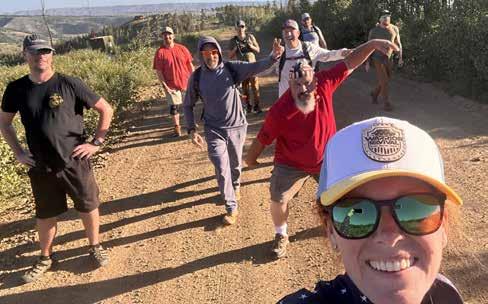

community to help us.”
In addition to the larger events, Warrior Revival members also gather for coffee hours and a monthly book club. The book club meets after business hours at Houzd Mortgage, 11550 S. 700 East, in Draper. Brandy Tilo, a realtor who served in the Navy, initiated the book club last year. “It kind of morphed into Warrior Revival,” she said. “We just got more and more veterans but anyone can come.”
Tilo explained that while some of the books they have read specifically address how to transition from the military, other books contain life lessons with more general appeal. “We read ‘The Let Them Theory’ by Mel Robbins and books by David Goggins,” she said.
“It’s funny how we end up,” she added. “There is a lot of crying and a lot of laughter. It’s become almost a self-help therapy session.”
The meetings, which start at 6 p.m., usually begin with a little socializing before the club members share their thoughts and perspectives on the book. They then collaboratively select a book for the next month.
“I never thought I’d get so much out of a book club,” Tilo said. “I look forward to that last Tuesday of the month.”
The Warrior Revival book club is made up of both men and women of all ages. “It’s a very mixed bag. Not all are military but I think that’s even better, we get different perspectives,” she said.
“We average about seven to eight people in the club,” Tilo said. “It’s our safe space so we don’t want it to get too big. But we certainly have room for more. It really is a good time.”
Fry emphasized that Warrior Revival serves all veterans. Recently, the organization hosted a virtual get-together and a lunch meeting just for women. “We are working on adding space for women to come together,” she said.
“We truly welcome everyone to join our community,” she said. “We welcome those who want to give back to our service members — those veterans and their families who have selflessly given so much to us.”
To learn more about Warrior Revival, visit warrior-revival.org.
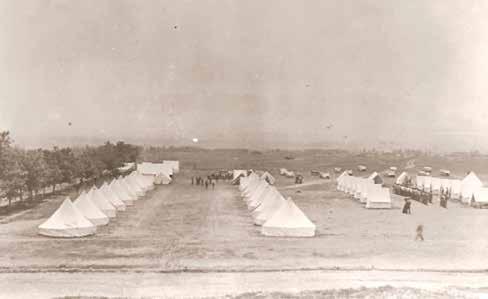

By Elisa Eames |
On July 25, a fun adventure turned into a harrowing ordeal for a man who was hiking near Idaho’s Leatherman Peak. While negotiating the rough landscape, he fell and sustained severe injuries, including compound fractures in both legs, stranding him at an extremely high altitude. Knowing that Utah Army National Guard teams receive specialized high-altitude training at Camp Williams, the state of Idaho asked Utah for help that evening.
“Due to the extreme altitude, low moonlight and rugged terrain, local search and rescue personnel were struggling to reach the stranded hiker,” the 97th Aviation Troop Command said in a statement. The 97th Aviation Troop Command is the brigade headquarters, or the
unit overseeing the command and administration of a brigade, for Utah National Guard Aviation Battalions, including the 2-211th General Services Aviation Battalion, which supplied rescue volunteers.
In an HH-60M Blackhawk helicopter equipped with just the kind of rare machinery the situation demanded, a West Jordan-based medical team of volunteers from the 2-211th General Services Aviation Battalion began its hurried flight to Idaho. Following a stop in Idaho Falls to refuel, the team was able to locate the hiker in near pitch-black conditions after reaching his last known position.
“[They] conducted an extremely difficult and technical hoist operation, lowering their on-board medic onto the steep terrain to begin immediate care of the

hiker,” the 97th Aviation Troop Command said.
When the medic was able to stabilize the man, the helicopter used a hoist cable to bring him on board while hovering in mid-air. The operation took place at approximately 10,500 feet above the average sea level. The hiker continued to receive lifesaving medical care as the Blackhawk sped to meet a waiting civilian emergency transport helicopter, which transferred him to a medical center.
“This is a mission that the Citizen-Soldiers of the Utah Army National Guard are uniquely qualified for and stand ready to conduct at a moment’s notice,” the 97th Aviation Troop Command said.
Many locals don’t realize that the training that makes rescues like this possible happens in our own backyard. “All units within 97th Aviation Troop Command train at Camp Williams routinely as a primary training site for members of the Utah National Guard,” Tamara L. West said. West is the public affairs officer for the Utah National Guard, which was organized in 1894.
Camp Williams was established in 1914 as a training ground for the National Guard during World War I, though it was a fraction of its current 24,063 acres and hadn’t yet received its official name. In 1927, permanent and semi-permanent structures were built on the site, and a year later, the camp was named for Brigadier General William Grey Williams to recognize his role in founding the training location and for his service in the Spanish-American War.
The camp continued to grow, and after the bombing of Pearl Harbor in 1941, the U.S. Army took control of the complex, using it as a main training center for
active-duty troops. Oversight of Camp Williams was returned to Utah in 1947, and since then, it has played an important role in training troops who would serve in Korea, Vietnam, the Cold War, the Persian Gulf, the War on Terror and even during the state’s COVID-19 response.
Today, the camp provides extensive combat and rescue training for the Utah National Guard, serves active-duty and reserve soldiers and hosts youth and civic groups. It also supports civilian, federal and state entities, including local, state and federal law enforcement organizations. The 97th Aviation Troop Command even executes flyovers for Provo’s annual Stadium of Fire celebration.
“The Utah National Guard performs missions at the request and approval of our governor and trains [at Camp Williams] to support our state and civil authorities in a wide range of capabilities,” West said. “[It] regularly supports our state and communities with wildland fire support, technical rescue, debris removal and hazardous materials monitoring and assessment…”
“Herriman City values its longstanding partnership with Camp Williams and the Utah National Guard,” Herriman Communications Manager Jonathan LaFollette said. “We work closely on land use, public safety, wildfire risk mitigation and community coordination to ensure residents and the Guard can thrive side by side.”
In addition to a mine detection course, small arms firing ranges and a land navigation course, there are ranges for artillery, mortars, grenades and demolition, offering training and certification for every weapon the Army has. “The Camp plays an important role in national

defense and in supporting emergency response, training and coordination across Utah and neighboring states,” LaFollette said.
The camp also includes classrooms, warehouses, dining facilities, a fitness center, workshop spaces and administration and maintenance buildings.
The training sessions are often the cause of the startling booms that residents sometimes hear and feel.
“Camp Williams is a primary training area for the 65th Field Artillery Brigade… as well as the 640th Regiment Regional Training Institute,” West said. “Loud booms heard are practice and live artillery rounds being fired, usually from M109A6 Paladin howitzers and M119 howitzers as
part of required training and certification. Artillery units work diligently to balance their training requirements with the impact their activities have on the populations surrounding training areas.”
To ensure units and individuals are always ready to serve, the camp receives soldiers from around the state and the nation for training in authentic and harsh conditions. “The Utah National Guard is comprised of citizen soldiers and airmen, neighbors and friends, and is proud to assist our communities, state and nation when called upon,” West said.
“We recognize the sacrifices and contributions of Guard members and appreciate the strength they bring to our region,” LaFollette said.

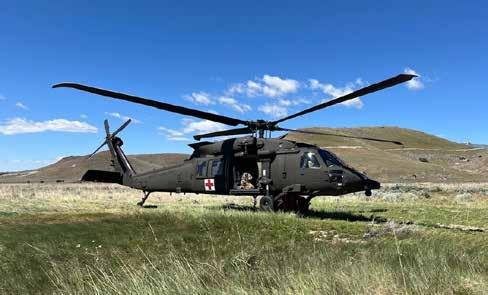
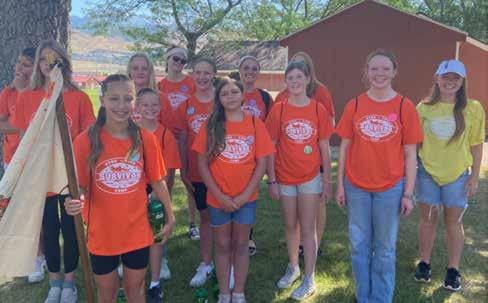
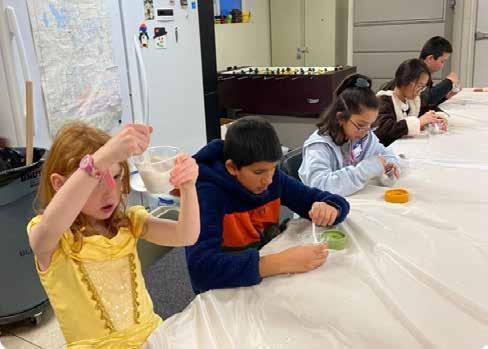
By Holly Curby | hello@hollycurby.com
Veterans Day is more than a date on the calendar. It is a living, breathing reminder of the courage and sacrifice woven into the fabric of our nation. According to the U.S. Census Bureau, there are currently more than 16.5 million veterans living in America. Each of these individuals carries a story—of service, dedication and an unwavering commitment to something greater than themselves. Each story is unique, but all are part of the same powerful legacy—one of sacrifice and honor.
I’m proud to come from a family that has served across many branches of the military:
• My grandfather, U.S. Army
• My uncle, U.S. Marine Corps
• My dad, U.S. Air Force
• My brother-in-law, U.S. Navy
As former President John F. Kennedy once said, “As we express our gratitude, we must never forget that the highest appreciation is not to utter words, but to live by them.” This quote serves as a call to action. It reminds us that true appreciation goes beyond simple thanks—it shows up in how we live, how we support our veterans, and how we uphold the freedoms they fought to protect.
• 1 in 10 U.S. adults is a veteran.
• Nearly 30% of the federal workforce is made up of veterans, continuing their legacy of public service.
• Over 45% of post-9/11 veterans say that adjusting to civilian life has been difficult—highlighting the ongoing support many need even after their service ends.
And let’s not forget: service extends beyond those in uniform. As former First Lady Jill Biden noted through her “Joining Forces” initiative, “When you go to war, we go with
you. We bear it, too.” Military families serve in quiet but profound ways—keeping households running, enduring long absences, and carrying the emotional weight that comes with every deployment. To every military family: thank you.
So what can we do to honor veterans in meaningful, everyday ways?
1. Practice Active Gratitude
Not all veterans served in combat, but all made sacrifices. When in doubt, a respectful “thank you for your service” goes a long way. Asking what branch they served in can be appropriate—but always read the room. The goal is appreciation, not interrogation.
2. Support Veteran-Owned Businesses
Many veterans transition to entrepreneurship after service. Whether it’s a local coffee shop or a clothing brand, supporting their business helps them thrive. For example, we often visit a veteran-owned eatery in our local mall— something as simple as buying a drink or a meal can make a difference. If they’re comfortable with it, consider giving them a shout-out on social media.
3. Volunteer or Donate
Organizations like Wounded Warrior Project and Fisher House Foundation provide essential support to veterans and their families. My family has cooked meals for guests staying at Fisher House and even handed out Chick-fil-A sandwiches at our local VA hospital. These small acts of kindness ripple farther than we may ever know.
4. Take Time to Listen
Years ago, I had the privilege of helping organize an event honoring Pearl Harbor survivors. More recently, I’ve sat with my dad and brother-in-law as they shared their own experiences. These conversations are priceless and ensure their stories live on for generations.
5. Live a Life Worth Their Sacrifice
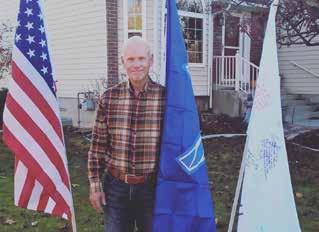
As Kennedy said, it’s not just about words. It’s about honoring their legacy by being active, informed citizens who live with purpose and responsibility.
Veterans Day isn’t only a time to reflect—it’s a time to act. This week, I challenge you to do one tangible thing to honor a veteran:
• Call a family member who served
• Write a thank-you card
• Support a veteran-owned business
• Volunteer with a local veterans’ organization
Learn more on Holly’s Highlights podcast, available wherever you stream podcasts, including www.hollycurby. com. Let’s transform gratitude into action. To every veteran and every military family: Today and always, we honor you. Thank you for your service.
‘Hunt. Fish. Feed.’ brings Utah’s military families and community together
The meal showed gratitude for Utah’s airmen.
By Peri Kinder
peri.k@thecityjournals.com
Behind every military mission, family members and communities stand to support their loved ones in the U.S. armed forces. In September, Comcast partnered with Hill Air Force Base, The Boyer Group and Sportsman Channel for the “Hunt. Fish. Feed.” event that honored airmen and their families.
The “Hunt. Fish. Feed.” outreach program was created by Sportsman Channel 17 years ago to address hunger issues across the nation. Using donated game meat and fish, the events have served more than 42,000 meals to communities all over the country, led by noted game chef Paul Comes.
During the event at Hill Air Force Base, hundreds of airmen and their families were served a meal, including Master Sergeant Dale Clark.
“All the events and all these organizations help us in the military and make us feel like we’re supported,” Clark said. “I have airmen who are struggling financially or, whatever the case may be, but these helping agencies really contribute a lot to health and morale.”
The event brought families together to enjoy a meal, connect with friends and take a break from the hectic pace of daily life.
Jeffrey Brown, director of Sportsman Channel’s distribution and affiliate marketing, said they are taking the “Hunt. Fish. Feed.” program to every Comcast region throughout the country, including one other military base.
“We just came off the anniversary of 9/11 and we appreciate the service that they’re doing. That goes without saying,” Brown said. “But to be out here and provide them a nice meal, it means so much to us. These are our brave warriors who are out there defending the red, white and blue every day.”
Supporting military families is central to Comcast’s mission. With thousands of employees who are actively serving or veterans, including founder and WWII Navy veteran Ralph Roberts, the company is committed to creating opportunities and providing support for those in uniform.
Comcast Mountain West Region’s Technical Operations Senior Manager Shawn Kessler joined the Marines in 1996 and was deployed to Iraq in 2003. He said events like “Hunt. Fish. Feed.” support military personnel and the challenges they face every day.
“It’s so cool being part of Comcast,” Kessler said. “What we do with veterans,
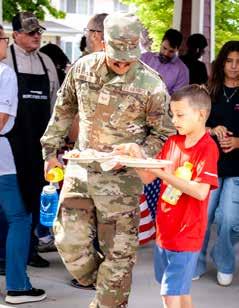
er it’s from a job standpoint or from a mental standpoint, that’s how Comcast leans in to support these folks.”
According to the Department of Workforce Services, Utah is home to more than 116,000 veterans, with the majority being 65 and older. A 2023 Blue Star Families report showed that more than 25% of active-duty military personnel experience food insecurity and homelessness remains a serious issue.
“We understand how important it is for the military community to be connected, be part of a community and also have a continued sense of service,” said Deneiva Knight, external affairs director, Comcast Mountain West Region. “Comcast is committed to supporting veterans and the military community through employment, economic mobility, and by ensuring the military community has access to connectivity and the digital skills to thrive in today’s world.
“We also invest in partners that support the military community throughout its entire lifecycle, from entry throughout the journey of service and beyond, including the families.”
like the internal networks and how many veterans we hire, is impressive. People are coming home and having to find careers and transition. Comcast does such an amazing job supporting these folks, wheth-
For more information about “Hunt. Fish. Feed.” visit TheSportsmanChannel. com. To learn about Comcast’s military customer programs, visit Corporate.Comcast.com. l

Let’s not split hairs—but this barber shop benefits both future barbers and community members.
By Jet Burnham j.burnham@mycityjournals.com
High school students who’ve accrued hundreds of hours experience with hair design and barbering skills on mannequins and friends need to practice their skills on real heads of adult hair.
“We have to reach 1,200 hours to license, but most of us get our license right as we graduate,” Riverton High School senior Natalie Roberds said. “A lot of people have been super kind to come in and let us practice.”
She said working on people’s hair is her favorite part of the hair design and barbering program at Jordan Academy for Technology and Careers, where she takes two classes each day.
“I love the hands-on experience,” Roberds said. “We don’t just sit in the classroom and do book work—we do have the days for that—but most of the time we’re in the salon actually working on people or doing mannequin work. That’s my favorite part.”
Program instructor Dacia Peterson said students get a lot of practice doing their friends’ hair and sometimes even pull students out of other JATC classes to practice on, but said that they are in need of more experience with other hair types and styles to become well-rounded professionals.
“Teens are not the number one demographic they will be working with,” she said. Peterson would like to see older adults take advantage of the early morning barbering hours so students get more experience with adult hair styles and working with thinning and receding hair challenges.
JATC Vice Principal Stewart Hudnall is a regular client at the shop because he enjoys supporting his students but also because they do a good job.
“I am consistently impressed by the professionalism and growing skills of the students,” he said. “The instructors create an
excellent, supervised learning environment, and it is rewarding to see the students’ confidence and talents develop with each visit. It’s more than just a haircut for me; it’s about contributing to their education and helping them prepare for their future.”
Hudnall believes the barbershop and hair salon are a valuable asset to the community, not only because they provide training opportunities for students, but also because they offer more affordable hair services for members of the community.
Haircuts and hair styling appointments are $8 and a shave is $10.
“It’s way cheap because we are students, and they have to have their risk of us being students,” Roberds said. “But we have teachers to help us, so we’re going to give them the service they need.”
She said students are taught to work carefully so the service may take a little longer.
“There’s a lot of different ways you can cross check and, like, make sure your work is good, so they’ve been really good at teaching us those type of things,” Roberds said.
Riverton High School senior Daphne Brown said clients can expect to get a quality haircut.
“Since it’s our second year, and the first year we learned so much, that now I’m like, ‘Okay, I can do any of it,’” she said. “Teachers are always there to help us fix things, so nothing’s ever gone terribly wrong.”
Additional services offered by students include deep conditioning, scalp treatment, braiding, coloring and other chemical services.
The barber shop is open MondayThursday 8 a.m. to 10 a.m. for appointments and walk-ins.
Hair services (including coloring) at the barber shop and hair salon are available Tuesday - Thursday afternoons and evenings by appointment only.
The barbershop and hair salon are located on the second floor of the JATC South Campus, 12723 S. Park Avenue in Riverton. Appointments can be scheduled by phone at 801-412-1324 or email at JATChair@jordandistrict.org. l








By Peri Kinder peri.k@thecityjournals.com
odorless and colorless and could be the most dangerous thing in your home. Radon gas is a naturally occurring radioactive gas found in Utah’s soil and rocks, caused by the decay of uranium. When it accumulates, it can cause serious health risks, including lung cancer.
Utah resident Kerri Robbins found that out the hard way when she was diagnosed with stage 4 non-smoking lung cancer, which metastasized into brain tumors. She met oncologist Dr. Wallace Akerley at the Huntsman Cancer Institute, who guided her treatment.
“I was absolutely floored,” she said. “Dr. Ackerly asked if I ever smoked. I never smoked. He asked if I had tested my home for radon. I didn’t know that I needed to; that’s the first time I realized that radon was a possibility for causing my cancer.”
She got a free radon test from Utah Radon and was shocked by the results. She learned the radon level in her home was so high, it was equivalent to smoking three packs of cigarettes a day. Robbins and her husband, Ron, had the radon mitigated and now monitor levels in their home all the time.
The cost of mitigation is around $2,000. Robbins said that the price tag is less than having to go through a cancer diagnosis and treatments. “Let me tell you, mitigation is cheaper than cancer,” she said.
Now, Robbins partners with Utah Radon to educate the public about the dangers of radon gas. Her dedication earned
her the 2024 IEA Radon Advocacy Award, given to just one U.S. citizen annually.
Utah has high levels of naturally occurring radon due to the state’s geology. Gas can enter homes through cracks in the driveway and foundation and build up over time. Right after smoking, it’s the second most common cause of lung cancer.
Utah Radon uses giant inflatable lungs to raise awareness about the dangers of radon. Taking the display to community events and public gatherings, the lungs attract attention so families can learn about radon detection, an easy test that could save lives. Almost one in two Utah homes tests high for radon.
“Forty-nine percent of Utah homes have dangerous radon levels,” Utah Radon Board Member Brad Callister said. “The only way to detect radon is to test for it. Testing is easy and free through Utah Radon. If your home has high levels of radon, a permanent radon mitigation system can be installed by a certified professional.”
New studies also link radon exposure to childhood leukemia, which occurs at higher-than-average rates in Utah. Robbins faces more cancer treatments as her tumors continue to grow, but she hopes her message can help save lives so people can avoid going through her experience.
“Cancer has changed a lot of things in my life,” Robbins said. “If it had been 20 years ago, I think I would have been dead, but the technology they have today keeps me going. Get that test from Utah Radon; it’s simple to do.”
For more information, or to get a free radon test, visit UtahRadon.org.l
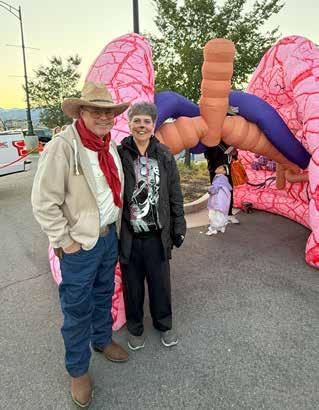



















Former Riverton teacher’s story spans decades of dedication, proves good coaching knows no gender.
By Julie Slama j.slama@mycityjournals.com
It’sbeen more than 20 years since Mary Kay Amicone made history at Jordan High – the first woman in Utah to coach a high school boys’ baseball team. But Amicone, a 2025 Utah Sports Hall of Fame inductee, never set out to change the playbook for women in Utah sports. She just loved the game.
She grew up in Southern California, always in the lineup with her brothers and neighborhood kids.
“My only friends were boys in the neighborhood because I had two brothers,” Amicone said. “There were lots of opportunities for playing on teams or after-school programs where you learned how to play sports.”
Amicone’s mother, a former Orange Lionette fastpitch softball player, signed her daughter up for Bobby Sox softball at 8, her first official at-bat in organized sports.
“It was the only organized team sport for girls at that time. I had played a lot of baseball. There often was a game of Over the Line and whoever was available would play,” she said.
After moving to Utah in junior high, Mary Kay Anderson, as she was known then, kept her eye on the ball — playing volleyball, basketball and softball at Murray High.
“At Murray, there was only one gym and who took the gym? Of course, the guys,” she said about the mid 1970s. “In those days, they were just starting women’s sports, so we would go to Field Days and play a round robin tournament. We played in our gym suits; we didn’t have any uniforms — but we were grateful for the opportunity to play.”
Amicone kept swinging in college, playing softball at Weber State and later the University of Utah, serving as team captain at both.
“After my sophomore season, the news broke Weber State softball would no longer be sanctioned. It was devastating. They decided not to sponsor it saying it was too expensive. But honestly, softball wasn’t that expensive. We didn’t have equipment back then. We didn’t wear helmets. We had about three to four bats. We had our own gloves. The costs were uniforms and travel, so there was really no logic to it,” she said.
At the U, Amicone’s team played in the Association for Intercollegiate Athletics for Women World Series — her first taste of postseason play on the national stage.
“It was cool to play there; it was quite an event,” she said.
While teaching at Riverton and Oquirrh elementaries and playing in fast pitch and slow pitch leagues, Amicone found herself in the coaching box at the U of U as an assistant. She married Marc, former U of U associate athletic director and later president of the Salt Lake Bees; his upbringing also was deeply rooted in softball and baseball.
“I loved coaching. I always felt like coaching was teaching,” she said. “I feel I was a trailblazer in women’s sports. I was one of the only coaches at the time who had children, and there were times when people doubted me. I’d say, ‘Don’t hold me back. I can do this if you’ll let me manage that situation.’”
The Amicones’ support system — including her mother, in-laws and friends — often pinch-hit when they needed help.
During Amicone’s career, she called signals at nearly every level: Brigham Young University, Salt Lake Community College, Weber State University as well as Bingham High, where she was an assistant coach for girls basketball and softball. Her collegiate coaching record includes more than 800 wins, multiple conference titles and several trips to the postseason.
As BYU’s first softball coach in 2000, she helped the Cougars clinch the Mountain West title in their second season. But after a “difference of philosophies” with the women’s athletic director, Amicone walked away from the program.
Around that time, life threw her a curveball — the sudden death of her younger brother, the last surviving member of her family, from a brain aneurysm.
“I was really down. I wasn’t sure I wanted to coach again so I was going to go back to elementary school teaching,” Amicone remembered.
Then Jordan High’s athletic director, Marc Hunter, made a clutch call. He urged her to apply to be the school’s baseball coach.
“I said, ‘I don’t think so.’ He went on, saying, ‘You’re the best coach I know,’” Amicone said and conceded. “I had zero idea I’d be coaching there. I did not know that coaching boys was an option — none — but they decided I was the best candidate for the job.”
With her sons in the program’s lineup — Trevor on varsity and Derek, a freshman — Amicone found herself back in the dugout.
“At first, it wasn’t a gender thing. It became a gender thing when we started playing against other schools where, it was quoted, ‘We’re not going to lose to that woman.’ I was like, ‘Well, you’re not playing against the woman; you’re playing against our team,’” she said.
Amicone said the heckling turned ugly — and some, played out publicly.
“Your son shouldn’t be hit by a pitch because his mom is the coach. Anytime he (Trevor) was in the game, the message was sent. I had this conversation with him: ‘If they pitch inside, just roll in and own it. You’ll get on base.’ It was very hard for him,” Amicone said. “It was poor for the opposing team because those young men had role models with gender issues, and they set the tone; they were an embarrassment to be called coaches.”
Despite the challenges, the team made a run for the title, finishing second in state. That’s when Amicone got the call to return to softball — at SLCC.
“I sat down with Trevor and told him I was proud of the
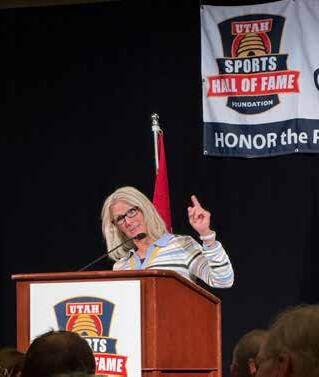
way he handled the season, but then I asked him, ‘What do you feel like is the best decision for me and for you?’” she said.
He encouraged his mom to accept the coaching job at SLCC where she led the Bruins to seven conference titles in nine seasons.
“I left Jordan’s program in a great spot. The next year, they won state. It was incredible to watch and fun to know I was a part of the grassroots of this championship team,” she said. To Amicone, good coaching is good coaching — regardless of who’s on the roster.
“As a coach, you want to bring out the best in them. I coach them hard; that’s what I know. Kids need guidance,” she said.
Now retired, Amicone is still active — trading cleats for court shoes with pickleball and racquetball and enjoying life as a grandmother. But her clubhouse includes her former players.
“I’d like to think if we could all relate to one another as team members and be a good team member in society, we’d be much better,” she said. “With my teams, I don’t have to be their coach anymore, but the relationships can continue as friends.”
In late September, several former players and coaches were part of Amicone’s team, celebrating her induction into the Utah Sports Hall of Fame. l

A variety of resources are available to support parents who want to improve their student’s attendance habits.
By Jet Burnham j.burnham@mycityjournals.com
Parents have a significant role in ensuring their children are attending school regularly. However, the West Hills Middle School’s attendance team discovered that when they reached out to parents of frequently absent students to help address the problems, the parent support events they planned were poorly attended.
The first year, five families out of the entire elementary, middle and high school feeder system showed up. Last year, when 400 families received a personal invitation, the turnout was even more discouraging.
“Not one family showed up. Not one parent,” WHMS Clinical Support Specialist Andrew “Link” Simpson said.
Parent education is a major focus of both the statewide Every Day Counts attendance campaign and Jordan School District’s attendance initiatives. The Utah State Board of Education has provided a toolkit of infographics and slides which help educate families about the negative impacts of frequent school absences.
Copper Mountain Middle School regularly shares these messages with parents
through social media, ParentSquare and other school communications.
“We’re doing a multifaceted campaign— as many touch points as we can—to emphasize that attendance is important,” CMMS school counselor Hailey Sutterfield said. “Especially after 2020, where a lot of people felt like attendance isn’t important, we’re trying to get the word out that it is actually important and that it is valuable to be at school.”
Jordan School District Attendance & Prevention Specialist Michelle Reyes said one common misconception is that absences aren’t a big deal because students can virtually access the assignments they missed in class the same day.
“One of the things we’re doing to try and combat that is to let families know that school isn’t all about academics and that there are other very important skills that their students are learning from being in a classroom,” Reyes said.
Jordan School District’s student support website and Utah State Board of Education’s absenteeism and truancy prevention website provide a variety of resources to help parents prioritize school attendance.
There are resources for helping a child experiencing depression, anxiety, bullying, learning disabilities or other negative situations that cause them to avoid school. There are also ideas and links for families who struggle with transportation, childcare, family situations and economic obstacles that cause their child to miss school frequently.
Parents are encouraged to set an example of prioritizing regular school attendance by scheduling their child’s medical and dental appointments outside school hours whenever possible and taking family trips only during school holidays.
While some parents allow older children to take responsibility for their own attendance, USBE materials suggest “teens still benefit from clear expectations, structure and support from adults.”
Parents’ responsibilities, by law, are to ensure their child attends school and to notify school staff when their child will be absent. The most common reason for an absence is illness, but Reyes acknowledges there is still some confusion, left over from the pandemic, about when it’s okay to send a symptomatic child to school.
“Even as a parent myself, coming off of covid, it was, ‘They have a sniffle today or a little cough. Can I send my child to school today or do I have to keep them home? Do they want them there or are they going to be judging them if I send them to school?’” she said.
Parents can check the school district’s website or their child’s school website for guidance, but generally, if the illness is contagious (high fever, vomiting, diarrhea, crusty eyes) the child should stay home.
When a child is absent for any reason, parents are responsible for contacting the school attendance office, preferably as soon as possible on the day of the absence. Parents aren’t required to disclose the reason for the absence,
however some schools like to collect that data. In some circumstances, a doctor’s note may be required to excuse an absence.
Reyes recommends parents become familiar with their child’s school attendance policies and procedures.
“Each school individually customizes how attendance is excused based on the community they serve,” she said. l

Interactive exhibits, student leaders and curious minds turned out for the 11th annual event.
By Julie Slama j.slama@mycityjournals.com
Amidthousands of students during the day and hundreds of families at night, an electric energy pulsed through the crowd at Utah STEMfest — and no lab coat was required.
Kids felt literal static electricity as they placed their hands on a plasma ball at the Clark Planetarium booth while others explored how electric currents work at a Rocky Mountain Power display. To cool off, they plunged their hands into insta-snow demonstrated by SheTech student leaders or touched sea stars, sea turtle shells and other marine life specimens at the Loveland Living Planet Aquarium table.
Three-year-old Poppy, brought along her 1-year-old sister, Delilah, and her dad, Jed Hall, eager to dive into the hands-on experiences available at the Mountain America Expo Center in Sandy.
“We like to do experiments at home, so I’m trying to foster a love of STEM in my little girl,” Hall said. “I hope she can have a better
understanding of the world. I want her to develop a love of learning while she’s young so she will keep it up when she’s older.”
It wasn’t just kids who were learning — volunteer Dannette Rose said she was helping because she wanted to expand her own STEM knowledge.
“I like to learn all kinds of stuff when I help; it’s a good opportunity to learn and explore,” she said.
Rose was assisting Denise Taylor, a Utah 4-H STEM and strategic partner with Utah State University. Together, they guided attendees through the Utah 4-H night sky star dome, encouraging them to look to the heavens.
“It’s important kids get exposed to lots of different things because STEM is in everything we do,” Taylor said, listing a vast array of 4-H clubs which all include STEM. “We just need to point it out to students. They can garden, and there’s science behind the soil and the growing process. They do robotics and we can talk about coding. They read Harry Potter and explore potions and wands and learn about chemical reactions and magnetic fields. When we go into elementary schools, sometimes kids say, ‘I don’t do STEM,’ but they don’t realize our world is engrossed in it, and it will be a big part of their future and is what they can do.”
Tami Goetz, director of the Utah STEM Action Center — the organization behind the 11th annual event, agrees.
“I have seen students trying to figure how to balance their love of STEM with other in-
terests and passions,” she said. “My advice to them has always been that they are lucky because STEM overlaps with so many other education and career paths.” l

Moving & Storage partners with Jordan School District to stock school pantries and support students facing hunger.
By Julie Slama j.slama@mycityjournals.com
To honor the National Day of Service,
InterWest Moving & Storage organized a community food drive benefiting students in the Jordan School District, especially those facing food insecurity.
Grab-and-go snacks were collected at the South Jordan Parkway Walmart, with additional donation boxes placed at B Space Salon, Beddy’s, Guild Mortgage, Millrock Management and Northwestern Mutual. More than 672 pounds of food was collected.
“We’re always about getting involved with the community,” Roman Fisher said, who works in sales and business development for InterWest Moving & Storage. “How are kids supposed to learn if their stomachs are growling because they’re hungry? They can’t focus so we need to get them food to help propel their life forward with what they’re studying.”
One in four Jordan students qualify for reduced or free school lunch, according to Jordan Education Foundation Executive Director Mike Haynes.
Fisher connected with Jordan Education Foundation member Tracy Miller at a South Valley Chamber of Commerce meeting.
“He introduced himself and said, ‘Let’s work together on something,’” she said. “Since the principal pantry is a big part of what the foundation does — stocking pantries at all 68 of our schools for those kids in need — he suggested a fill-the-truck event. It’s what we need to help students.”
South Jordan Parkway Walmart store manager Kevin Carlile offered his location as a drop-off site. Fisher handled logistics and rallied local businesses.
“We ran around and got some businesses involved and dropped off some boxes for donations,” Fisher said. “When I told the corporate headquarters in Idaho Falls, they were in love with the idea and wanted us to be a part of it.”
Haynes said filling school pantries is critical.
“Every year we start off with schools that have empty pantries,” he said. “We want to fill them as soon as possible.
A lot of our teachers also are stocking their classrooms with snacks. We provide classroom grants to teachers. Every teacher can get up to $500 and in the past, a lot of them have been asking for food to keep in the class for those students who need it. Now they just make it available to everybody. It’s equalized and it’s easier for those students in need to feel better about taking food supplies and other things.”
With community support, Haynes said funds can now go further.

cares about it too, and that helps shape how they see the world.”
Haynes said 800 snack packs were recently donated — and gone the next day.
“We don’t want to create dependency on us for their meals. We want to fill a gap that exists. If kids don’t have access to food over a weekend, we give them a weekend meal pack. During the day, those snack packs are super popular. It comes back to hungry kids during the day, and a learning curve. In the past, some kids were punished for bad behaviors without knowing why they were acting out. Now, our schools, teachers, administrators are asking questions, ‘What’s going on? How’s your morning been? Did you eat?’ Many of us access food when we need it, when we want it. Some of these kids don’t have that luxury,” he said.
Parent Liz Robinson, who has two students at West Jordan High, stopped by to donate granola bars and snacks.

“We now take that money and use it in other places to make a difference. In the last couple years, we’ve given out 750 beds for students who have been sleeping on the floor in homes. It’s heartbreaking to see, but we’re grateful to help. Public education is the place to help meet a lot of needs, more than just
education,” he said. “We have a great community who is willing to donate and help. Our mission is to engage the community to help provide resources that fuel success in the district and without community partners, a lot of what we do could never be possible. And it’s good for kids to see the community
“We heard about this service opportunity today and while I’m grateful we’ve never had to use a service like this, I’m thankful it is available for people who do need it, especially kids, because they have no control over when they are going to have their next meal,” she said. “We want to help make sure we’re taking care of everybody in our community.”
Fisher agrees: “This will help a lot of kids who are hungry; who better to help?” l


By Peri Kinder peri.k@thecityjournals.com
It’sestimated that at least 3 million Americans struggle with celiac disease, an autoimmune illness triggered by consuming gluten. Not only does eating products with gluten cause pain, bloating and cramping for people with celiac, it can ultimately damage the small intestine.
Gluten is a protein found in a variety of grains, including wheat, rye and barley. While doctors say most people shouldn’t avoid gluten, for those diagnosed with celiac or gluten intolerance, cutting out gluten products is the best way to feel better.
Eight years ago, organizers introduced the first My Gluten Free World Expo to people in Utah and this year it included more than 100 vendors introducing gluten-free foods and products. The event was held at the end of September at the Mountain America Expo Center in Sandy.
Local company, Grandpa’s Kitchen, was started in 2007. McKaelle Kauwe’s great-grandfather began the business to help family members with celiac disease who struggled to find quality gluten-free breads and cakes. The company offers gluten-free flour, mixes and recipes to improve the quality of life for those who can’t eat gluten.

“There was no good, gluten-free food in 2007,” Kauwe said. “He created a good flour blend and went through a lot of bad iterations to get to this point and now we’re trying to share it with the world.”
Kauwe said many gluten-free products are made with chickpea flour, which can leave a bitter aftertaste, and gluten-free bread can be dense, gritty and prone to falling apart easily.
The vendors at My Gluten Free World Expo are trying to build better products by using different flour blends and ingredients to create a more realistic flavor and texture to gluten-free foods. Amanda Wuerz started Hugz Snacks in Utah, selling vegan and gluten-free cheez bread inspired by her Brazilian heritage.
“It stands out for a couple of reasons,” Wuerz said. “First, I use freshly-grated cheese. My Colby Jack cheese is freshly grated and put into the dough. And I don’t use seed oil. It’s pure avocado oil and it’s made in small batches.”
Other products at the expo included seasonings, soups, cooking oils, lotions, soaps, cooking utensils, drinks, protein bars and desserts. Gluten-free testing kits were a big hit at the expo, giving people the opportunity to test foods in restaurants to ensure food safety.
Jill Smith is the chief technical officer of Leo Verified, a gluten-free detection kit to help relieve the stress of dining out. It only takes three minutes to get results, so people can make healthy choices quickly.


“I had not eaten au jus with prime rib for 31 years,” Smith said. “So I ordered prime rib, with the au jus on the side. Then I tested it and it was gluten-free. I wondered how many other things I’d been missing out on.”
Groups like Advanced Research Clinic attended the event to educate people about celiac disease and gluten sensitivity, and to recruit patients for a clinical trial that tests cutting-edge treatment for the disease.
Lynae Sorensen is an advanced practice nurse working with ARC. She said research into celiac and other autoimmune diseases is growing. Statistically, women are much more likely than men to be diagnosed with an auto-

immune disease and it can take years before it is identified. The average time for an autoimmune diagnosis is four to five years, but it’s often much longer.
“I spoke with a patient who had it for 11 years before she was diagnosed,” Sorensen said. “We’re learning more about specific chemical messengers that are attached to this disease. That’s where we can make specific medications to target those things. There’s a lot that they’re coming out with now and that’s exciting.”
For a list of My Gluten Free World Expo vendors, visit MyGlutenFree WorldExpo.com. l












A
By Jet Burnham j.burnham@mycityjournals.com
High School drama teacher Erin
McGuire created a compilation scene of clips from seven different Shakespeare plays to inspire an appreciation of the playwright, who often intimidates students.
“I think that this scene is one of those kinds of things that can show a real appreciation for Shakespeare,” she said. “It’s his greatest hits, all those things you go, ‘That’s where that came from!?’ There’s so much wisdom and art and beautiful lessons that are in it, so I want to be able to show some of that and have students be able to see it.”
The scene is set in a modern classroom in which a teacher begins with the “All the world’s a stage” speech from “As You Like It.” When it mentions the “seven ages of man” she assigns lines to students from seven different plays that illustrate each age. The scene progresses as reluctant students, initially uninterested, begin to understand and become more engaged in the lines. Their performances improve, and they become more animated and emotionally invested, culminating as they reach the final age, in which a student movingly portrays the deep sorrow of death, the final age.
The Shakespeare team performed McGuire’s scene for some of the student body, along with other theater and dance performances, before they headed to the Shakespeare Competition in Cedar City the first weekend in October.
Students who attended the assembly with their language arts classes said the performances were “awesome,” “great” and “so good.” One said, “It was very fun to watch and didn’t leave me bored at all” and another said “I saw the passion.”
“It was very interesting to see their perspective on Shakespeare,” a theater student said. “It made me enjoy it way more than how
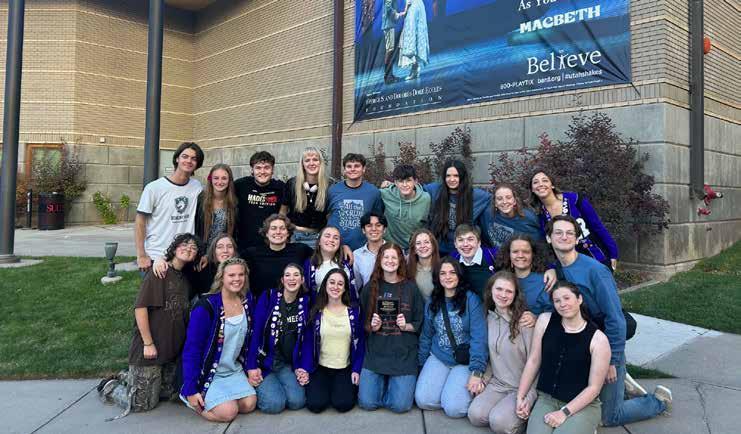
I’ve seen it before.”
Cece Heiner, a senior on the Shakespeare team, admitted she didn’t like Shakespeare until she studied his plays in school. She enjoyed being part of the mashup scene.
“I love putting Shakespeare into the modern setting, because it’s easy to see that even though it’s an older language, it still resonates with people today, and the themes and topics in those shows are still prevalent today,” she said.
Junior Carlos Boscan, who performed the death scene in the ensemble piece, said two friends told him afterward that his performance had changed their opinion of Shakespeare.
“They were like, ‘I don’t like Shakespeare at all. I don’t like theater, and you made me get into that scene, you made me
get into that story,’” he said. “And I just feel so grateful. That makes me know that maybe I am doing a good job.”
Two years ago, Boscan didn’t even know English and now he is a member of the RHS Shakespeare team.
“When I was in Venezuela, and in Panama, I didn’t know anything about Shakespeare,” he said. “When I got here, thanks to Mr. Eaton and Miss McGuire, I have been able to learn so much from Shakespeare. He really is the best playwriter of the whole world.”
The modern compilation scene was something McGuire has wanted her team to perform for a couple of years. She knew it was a risky interpretation for a competition piece but she thought it would be a good experience for
her students.
“I like to have more creative stuff going on and do things that are unexpected, mostly for my students so they can get a different perspective of Shakespeare,” McGuire said. “I know that some of the judges are going to love it and some are going to hate it—I don’t care, because the students think it’s cool, and I think it’s cool, and other people who see it, who love Shakespeare, will think it’s cool.”
Those who saw it at the competition did think it was cool—including the judges. The scene won third place in their division and was selected as an overall favorite.
“The ensemble was asked to perform at a showcase, which means judges believed the scene should be seen by other participants,” McGuire said. l



The recent shooting of Charlie Kirk was a wake-up call for Americans who value free speech. What drives someone to fear opposing views so deeply that violence feels justified? If we want to cool our nation’s overheated politics, each of us can start with three changes.
1. Don’t call names or label the other side. Our country was founded on the belief that open debate makes us stronger. The Founders argued fiercely when crafting the Constitution—and that was healthy. But when disagreement turns into name-calling, the conversation collapses. History shows that dehumanizing language can fuel tragedy; in Rwanda, propaganda that labeled the Tutsis as “cockroaches” helped spark genocide. Calling people “evil” or “dangerous” never changes minds. Respectful discussion does. Express your beliefs firmly but without vilifying others. The moment you deny someone dignity, your argument loses power. One way to rebuild civility is to teach debate skills in middle school and high school classrooms so the next generation learns how to disagree productively.
2. Listen more than you speak. None of us is right all the time. Listening with empathy to those who see things differently



can preserve friendships and strengthen our communities. Try this: ask someone with an opposing political view to explain their perspective for 5-10 minutes. Repeat back what you heard, thank them, and resist the urge to argue. It’s hard—but it’s how understanding begins.
During my 12 years on the Salt Lake County Council, I’ve served on a body that’s often split almost evenly between Republicans and Democrats. We debate passionately, sometimes disagree strongly, yet still shake hands afterward. We recognize that each member represents different constituents and experiences. Even when votes fall along party lines, mutual respect keeps us working together. I’m proud of that example of civil governance.
3. Recognize how you’re being manipu-



lated. Social media algorithms are designed to provoke emotion, not inform. Once a platform detects your political leanings, it floods your feed with fear or anger-inducing content to keep you scrolling—and advertisers paying. Limit your time online.
Keep in mind that each side is driven by this algorithm that fuels the flame of conviction. We question how the other side can be so out of touch, yet they simply don’t see what we see. Those on the other end of the political spectrum have never been shown the version of the story we know. Perhaps we are both right, but perhaps we are both wrong. It’s time to pause before the contempt destroys our country.
Cable news isn’t much better. Filling 24 hours of airtime pushes networks to amplify outrage and tailor coverage to partisan audiences. Try this experiment: if you watch a story on Fox News, switch to MSNBC for the other perspective, or vice versa. The truth may lie somewhere in between.
As we navigate the future, it’s important that we put down our phones, turn off the TV, and talk to real people. Human connection improves mental health and builds relationships. When the political climate feels toxic, step away from social media and find a friend to visit with—no debating required.


Our democracy depends on citizens who can disagree without demeaning, listen without shouting, and stay informed without being manipulated. By resisting name calling, listening with empathy, and unplugging from outrage, we can help lower the temperature, strengthen our communities, and set an example for the next generation that is watching us closely.
















It’s not a good sign when a season has its own mental disorder, but here we are, entering the dark, cold, abysmal days of post-Daylight Saving Time when Seasonal Affective Disorder destroys all joy. Darkness descends like a roiling thunderstorm in a fantasy novel, erasing all sunshine and leaving us cowering in the cellar.
My husband thinks I’m dramatic, but I tell him to stop calling me names, as I drape across the fainting couch, gently dabbing my tears with a silken handkerchief.
Anyway.
This year, Seasonal Affective Disorder has been changed to Seasonal Affective Despair as we watch the nation’s slow descent into malevolence and madness. Night falls immediately after lunch, pajamas are my goto wardrobe and my serotonin levels drop as quickly as my faith in humanity.
As we move toward winter, light deprivation should be considered a national crisis. Maybe we need a Vitamin D shot mandate or, at least, red light therapy lamps to replace all street lighting. Utah recently eliminated fluoride in the water; could we add a dash of Xanax?
I know there’s a fine line between hibernation and hiding, but maybe the bears have it right. Spend the summer and fall eating ev-




Peri Kinder Life and Laughter

erything in sight, yank fresh salmon right out of the river, compete for the World’s Fattest Bear and then sleep until the sun returns.
Therapists recommend regular exercise, a healthy diet and sufficient sleep to improve mental health and reduce Seasonal Affective Despair symptoms, but nobody listens to their therapist; otherwise, we wouldn’t be in this national mess.
Someone on TikTok suggested organizing craft projects to get me through the dark months, but my closet is already full of discarded creations, including featherless pinecone turkeys and the unfinished baby blanket I was making for my first grandchild (who is now 21).
As I sorted through a tangle of thread from my last embroidery project and a cubic pound of glitter I bought when I thought making glitter angels with the grandkids was a good idea, I decided starting something




new wasn’t a good idea. Plus, I still have glue gun scars from my Halloween projects.
Maybe I can spend the next few months snuggled with a book by the fireplace (if we had a fireplace), enjoying a bowl of minestrone (just kidding, my husband hates soup) and trying to live with someone who hates soup.
I’ll be poppin’ melatonin gummies like, well, like gummies, and giving it my best to be optimistic in a season created when a god of the underworld kidnapped a young girl and held her hostage for six months. On a coincidentally bright note, pomegranates are back in stores.
At least Thanksgiving is coming up, when I can get my emotional support food: mashed potatoes.
As we move toward the end of the year, November offers an invitation to look back at the previous months to see…nope…never mind. Don’t do that if you’re looking for sunshine and rainbows. In fact, maybe throw your phone in the Great Salt Lake (if it still had water), disconnect from the internet, delete your social media pages and go off-grid until May.
Mentally prepare yourself to spend several months trapped in a home with kids, or grandkids, who won’t stop saying, “6-7” or muttering Italian Brainrot nonsense.





Maybe this year’s Seasonal Affective Despair will be the start of my superhero origin story. When the light finally returns, I’ll stumble into the sunshine, wearing wrinkled pajamas and gripping a glue gun, ready to battle the forces of evil.















